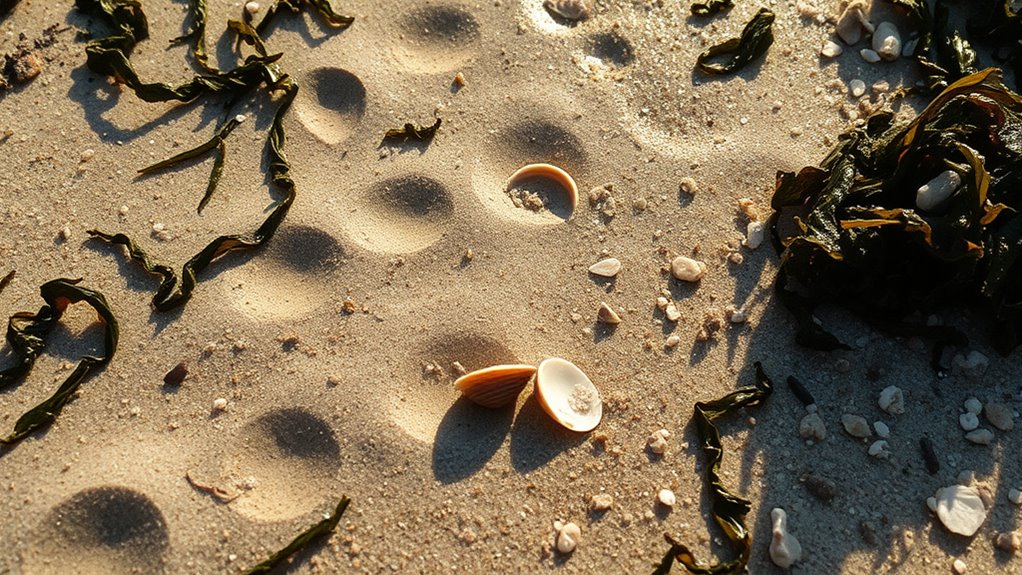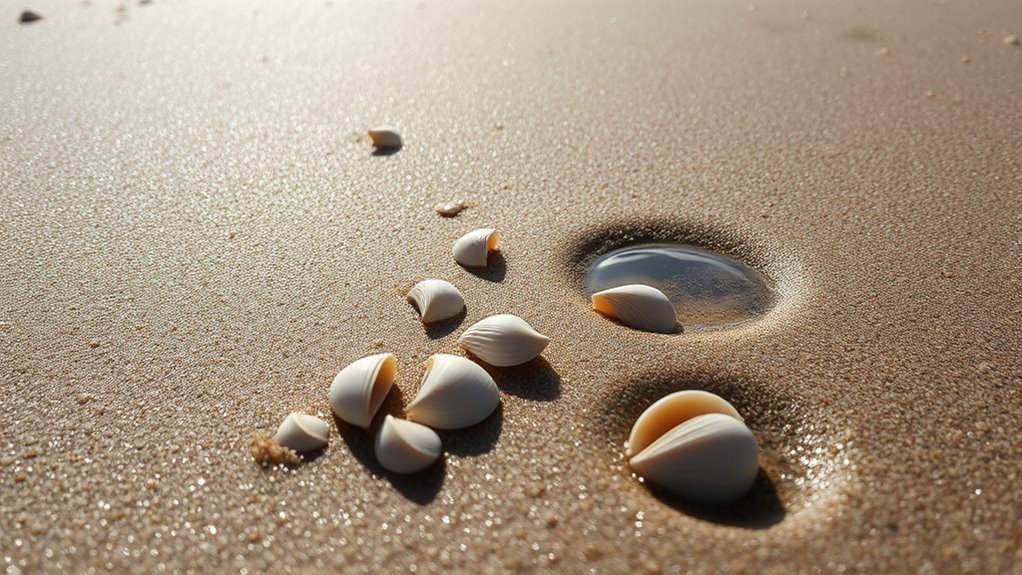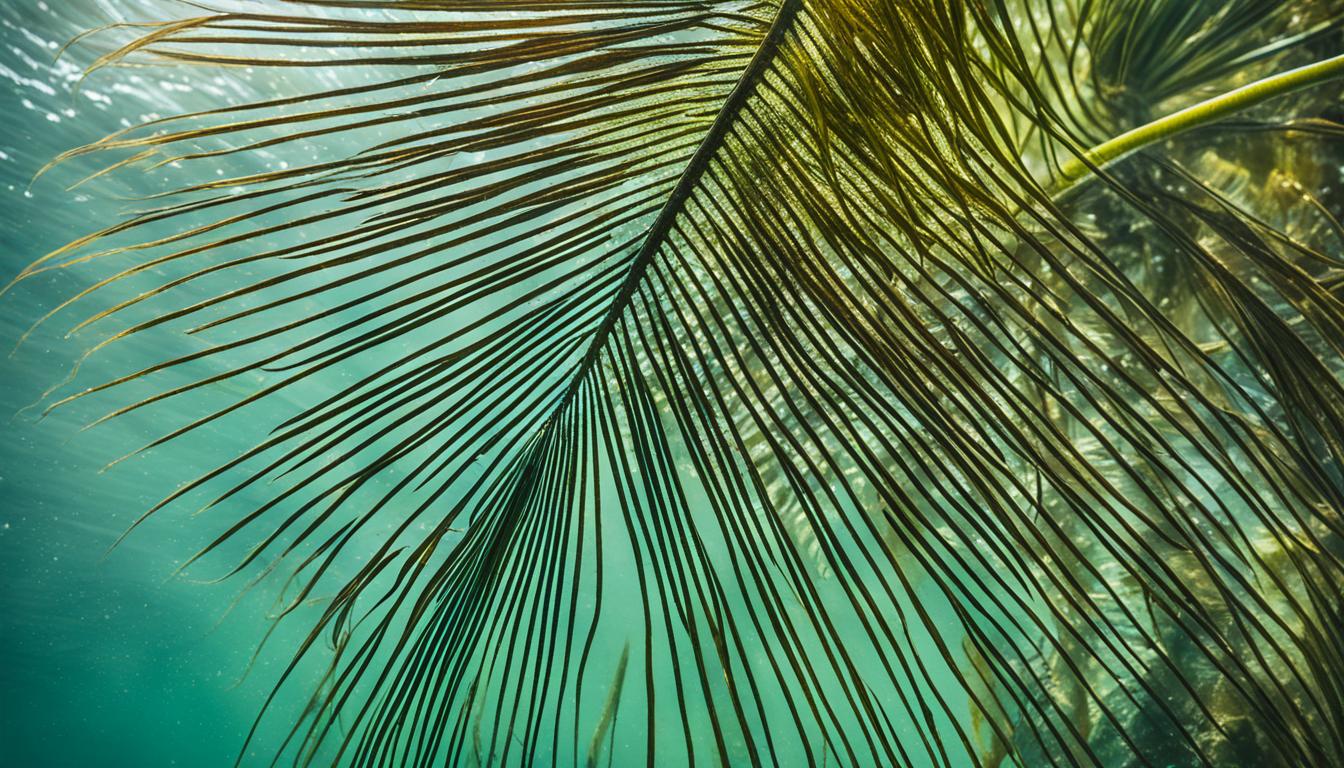After a storm surge, you can find buried clams by carefully examining the shoreline. Look for disturbed sand, small round depressions, or tiny holes that mark burrow entrances. Sand mounds around these holes may indicate active burrowing. Also, inspect shells in the area—symmetrical, oval shells suggest clams. Environmental clues like water pooling can help, and recognizing color and surface details is key. Keep exploring to discover more tips for uncovering hidden clams.
Key Takeaways
- Look for disturbed sand, depressions, and small circular holes indicating clam burrows on the shoreline.
- Search for sand mounds or raised areas around holes, suggesting clam surfacing or burrowing activity.
- After a storm surge, examine tidal flats and beaches where seabed disturbance exposes buried clams.
- Identify shells with symmetrical, oval shapes and check inside for moist tissue or siphons to confirm live clams.
- Use environmental cues like water pooling and subtle surface disturbances to locate active clam hiding spots.

Beneath the sandy seabed, hidden clams go unnoticed despite their essential role in marine ecosystems. After a storm surge, spotting these buried bivalves becomes a rewarding challenge, revealing the delicate balance of coastal life. To find them, you need to understand their clam habitat. Clams often settle in soft, sandy or muddy substrates where they can burrow easily. These environments are typically found along beaches, tidal flats, and estuarine areas. Storm surges stir up the seabed, exposing clues that can lead you to their hiding spots. Look for areas where the sand appears disturbed or where water temporarily pools, as these are often indicators of clam activity.
Your best first step is to observe the shoreline carefully. After a storm, the tide recedes, and the sand may reveal subtle signs of clam presence. Keep an eye out for small, round depressions or tiny, circular holes that disrupt the smooth surface of the sand. These are often the entrances or exits of burrows where clams hide. Sometimes, you might notice a slight mound of sand around these holes, caused by the clam pushing sand out while burrowing or surfacing.
Once you’ve identified potential spots, shell identification becomes essential. Clams vary in size, shape, and shell coloration, but most have a symmetrical, oval or rounded shape. Some shells might be smooth and shiny, while others are rough or covered with tiny ridges. Recognizing these features helps confirm whether you’ve found an active clam or just an empty shell. If you find a shell, gently turn it over to inspect the interior. Live clams usually have soft, moist tissue inside, and you might see the siphons or foot if you carefully open it.
Additionally, understanding color accuracy can help when observing shells and the surrounding environment, making it easier to distinguish between live clams and empty shells in varying lighting conditions.
Frequently Asked Questions
Are Buried Clams Safe to Eat After a Storm?
After a storm, you shouldn’t assume buried clams are safe to eat. Storm impact can introduce bacteria and pollutants into the water, contaminating the bivalves. Even if you’re clam harvesting, it’s best to avoid collecting or consuming clams immediately after a storm. Wait until local health authorities confirm water quality is safe, as storm surges often increase contamination risks and make it unsafe to eat buried clams.
How Deep Can Clams Be Buried Post-Storm?
You might think buried clams are always shallow, but after a storm, they can be hidden deeper—sometimes over several inches—due to changes in their clam habitat and sediment layers. Clams burrow deeper to protect themselves from turbulence and predators. Always be cautious, as digging beyond typical depths risks damaging their environment. Use a tool to gently probe, and remember, the depth varies based on sediment stability and storm intensity.
Do All Storm Surges Uncover Clams Equally?
Not all storm surges uncover clams equally. Factors like wave strength, tide levels, and sediment type influence how deeply clams stay buried. You should check local clamming regulations before harvesting, as rules vary by area. Use proper clam harvesting techniques, like gentle digging and careful handling, to protect the environment. Storm surges may expose some clams, but always be mindful of regulations and sustainable practices.
Can Storm Damage Affect Clam Populations Long-Term?
Storm damage can markedly impact clam populations long-term by causing sediment displacement, which buries or exposes clams unpredictably. This disturbance affects their habitat and disrupts breeding cycles, leading to ecological impacts like reduced biodiversity. You might notice fewer clams or changes in their distribution after a storm, indicating lasting effects. Protecting these habitats and monitoring sediment shifts are key to supporting clam populations and maintaining ecological balance.
What Tools Are Best for Locating Buried Clams?
Did you know that using the right tools can increase your success rate in finding buried clams by over 60%? To locate them effectively, you should use sonar technology, which helps detect their presence beneath the sediment. Hand trowels are also essential for carefully digging around the detected areas without damaging the clams. Combining these tools guarantees you can spot and retrieve buried clams efficiently after a storm surge.
Conclusion
Now that you know how to spot buried bivalves after a storm surge, you can appreciate the hidden treasures beneath your feet. Did you know that storm surges can uncover thousands of clams in just a single event? By paying attention to subtle signs, you not only protect your surroundings but also enjoy a unique glimpse into nature’s resilience. So next time, be ready to uncover these buried gems and embrace the surprises Mother Nature reveals.










